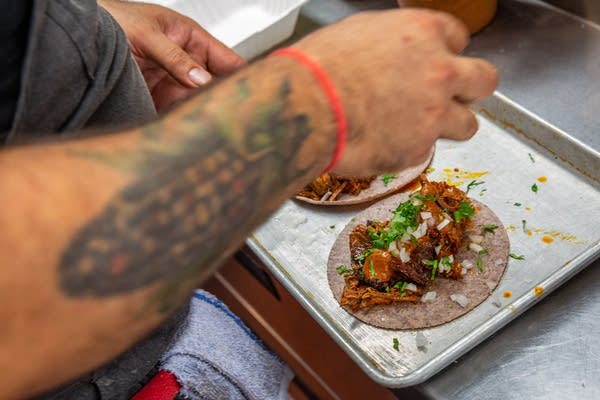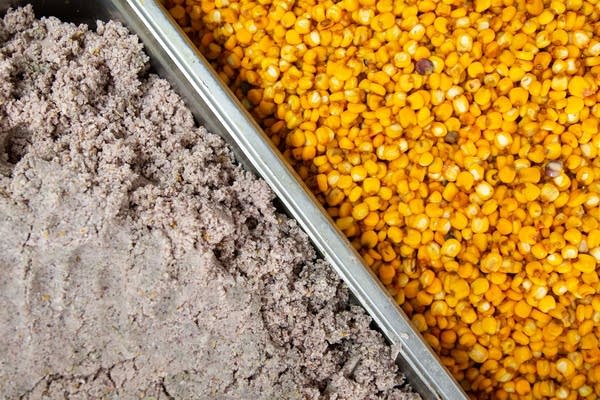The corn is the key
Chef and owner of Nixta tortilleria in northeast Minneapolis stays close to tradition to produce authentic flavors

Go Deeper.
Create an account or log in to save stories.
Like this?
Thanks for liking this story! We have added it to a list of your favorite stories.
Jars of colored corn line the window at Nixta. Large white sacks filled with corn sit in an alcove just off the entrance. Each sack is marked with the color and type of corn; the elevation at which it was grown; the name of the region it was grown in; and the name of the family who grew it.
Those sacks contain the key to the tortilla made by Gustavo Romero, chef and owner of Nixta.
Romero opened the tortilleria in July 2020 because he saw a necessity to bring a better tortilla to Minneapolis and the state.
He’s doing that one tortilla at a time using heirloom corn.
Turn Up Your Support
MPR News helps you turn down the noise and build shared understanding. Turn up your support for this public resource and keep trusted journalism accessible to all.
“The beginning of Mexican food is based in corn, and a lot of beliefs by ancient people is we even come from the corn — somos los hijos del maiz,” Romero said. “And for me, the beginning is the tortilla, the corn and the process.”
When he first moved to the United States, Romero recalled seeing corn crops for the first time.
“They’re all the same color. You look at the corn — it was this perfect white, yellowish corn. I used to tell people that where I’m from the corn looks different. It’s in different colors and in different sizes. And they didn’t really believe me,” Romero said.
Heirloom corn has a higher nutritional value than conventional corn and comes in a spectrum of colors. Its popularity has grown in the past few years. But in Mexico, heirloom corn was not always appreciated, and in fact often looked down upon.
“A lot of people saw corn as a class issue,” said Romero. “If you eat color[ed] tortillas, you’re from the pueblo. And the people who ate white and yellow tortillas were more in the cities.”
As a result, growers couldn’t sell their colored corn and began planting what everyone wanted to buy.
That has created a problem, Romero said.
“Now we are struggling to find some of these corns because people don’t want to grow (it),” he said.
The heirloom corn used for the tortillas is from Mexico. Romero works with the advocacy group Fundación Tortilla which promotes the growth of heirloom corn. The corn he uses comes from seven or eight different states in Mexico.
“One of the reasons that we collaborate with them and we love their work is because we know that we can go back into the ways of growing corn,” Romero said.
But what makes the Nixta tortillas different?

“This one tastes like corn,” Romero said. “For people who know and have been in Mexico and tasted the real corn tortillas, and you taste the ones that are in the market, it’s definitely a different taste.”
And besides the color, the texture is also different — some are softer, or drier, stiffer or more elastic. Some are better for tostadas while others “you can load up and they won’t break,” Romero said.
Many people have never seen colored tortillas and ask Romero what they use to make them look that way.
“Now they know a little more about us, they understand that that’s the color of the corn,” Romero said.
The way corn is supposed to look

The detailed artwork in the form of tattoos that grace Romero’s arms paint a picture of his life.
His right arm is all about cooking and being a chef. The focal point is an ear of heirloom corn that his cousin, who is an artist, drew. He got that tattoo seven years ago — long before Nixta.
“The way they treated corn (here) always stuck in my head. I always wanted to have something to be like, ‘No, this is the way it’s supposed to look like,’” Romero said.
His left arm is an homage not only to where he is from — Tulancingo in the Mexican state of Hidalgo — but also the people who play a key role in his life.
The image of the Atlantis of Tula peers out from his left forearm. It is one of the warriors that guards the ancient archeological site at Tula.
“They’re like the guards of the Aztec empire. You have to go through my town to get wherever you want to go,” Romero said.
Time to make tortillas

It’s production day at Nixta. The sound of the corn grinder fills the kitchen. The corn soaked overnight. It’s now time to turn the rainbow of corn kernels into masa — dough. Antonia Cervantes Morales pours the blue corn kernels into the top of the machine. She then guides the corn into the grinder watching as it turns to masa. Each rectangular silver tray holds 11 pounds of dry corn.

Romero calls her the “tortilla maestra.” And for good reason. She began making tortillas as a 9-year-old in Mexico helping her mom and family.
“We always made tortillas. In the morning, afternoon, evening. Because that’s what we ate and used in the house. Fresh corn tortillas,” Cervantes Morales said.
The masa will yield about 250 or 300 tortillas, but the number differs depending on the type of corn, she said.
Now it’s Lupita’s turn to start making tortillas. She can make about 700 in one hour. Lupita is the machine Romero had specially made in Mexico. He said he’s not really sure why they named her Lupita.
But before the masa is put into the machine, Cervantes Morales checks the temperature. The temperature has to be just right or the tortilla won’t cook properly.
The lump of pink masa goes in and in seconds a perfectly circular tortilla makes its way down the roughly foot-long belt to land on the comal, similar to a griddle.
Mexican food in America not like he remembered
Romero recalled the first time he ate Mexican food after arriving in the United States in 2000 as a 17-year-old.
“The first one was really bad. It was in Arizona. The food wasn’t what I was used to,” Romero said.
He remembered the restaurant being very busy. He ordered enchiladas. The plate was huge and he couldn’t even see the tortillas.
“All you see is this red sauce and cheese,” Romero said. “The flavor was not what I remember, it was sad in a way.”
Since that time, Mexican food has improved a great deal and Romero has a theory why.
A lot of young people were moving to the United States when he arrived.
“It was always Mexican or Latino people in the kitchens. All those kids came here and started working as dishwashers, and now they are chefs,” said Romero. “And they can put items in the menu and express themselves. I think that has created an explosion of amazing Mexican food in the states.”

And creating great Mexican food is what Romero is doing at Nixta.
But one thing stands out. Talk to Romero about the food he serves, and the conversation always comes back to corn. And there’s good reason.
“Everything is based on the corn,” he said.
Tlacoyos, tlayudas, molotes. These are some of the foods you can find in the mercados in Mexico where the cooks are constantly calling out to customers to take a seat on one of the plastic stools lined up in front of their puesto.
You can also find those foods on Nixta’s weekly rotating menu. Takeout is available Thursdays, Fridays and Saturdays.
And while Nixta may not have plastic stools, there are a couple of plastic benches and metal ironing boards serving as makeshift tables out front in case customers can’t wait to get home to eat.

As Cervantes Morales oversees Lupita and the tortilla production, Romero is busy preparing food for the day’s menu — tacos de birria, pollo and chuleta as well as molotes stuffed with chorizo and potatoes.
He wants to bring the Mexican food he grew up with to Minneapolis. And he’s doing that by going back to his Mexican roots.
“What I want is to represent my country properly. When people come here, they take an idea of what they get when they go to Mexico,” Romero said.
Jimmy Guzman Moreno discovered Nixta after looking for a place that sold tortillas. Guzman Moreno was born in Hidalgo, just like Romero.
On this late Friday afternoon, he stopped by for a dozen tortillas and tacos de birria.
As he sat on an outdoor bench waiting for his food, Guzman Moreno said, “It reminds me of my family’s food. The tortillas taste like how my grandma makes them.”
Correction (Aug. 27, 2021): An earlier version of this story misidentified the name of a dish in a caption as huaraches. The story has been updated to reflect that the dish is molotes.
Vicki Adame covers Minnesota’s Latino communities for MPR News via Report for America, a national service program that places journalists into local newsrooms to report on undercovered issues and communities.





